Facile access to chiral 1-pyrrolines through Rh-catalyzed enantioselective partial hydrogenation of unprotected simple pyrroles
Kui Tian,Gongyi Liu,Xiu-Qin Dong
a Engineering Research Centre of Organosilicon Compounds&Materials,Ministry of Education,College of C hemistry and Molec ular Sciences,Wuhan University,Wuhan 430072,China
b Suzhou Institute of Wuhan University,Suzhou 215123,China
Keywords:Chiral 1-pyrrolines Partial hydrogenation Unprotected simple pyrroles Regioselectivity Enantioselectivity
ABSTRACT Highly enantioselective Rh-catalyzed partial hydrogenation of unprotected simple 2-alkyl-5-aryldisubstituted pyrroles has been successfully developed,generating a series of chiral 1-pyrroline derivatives generally with excellent results(95%–99%yields,91%–96%ee).Moreover,2,5-aryl-1H-pyrroles were hydrogenated well in high yields and good enantioselectivities.This efficient protocol features easily accessible substrates,wide substrate scope,well functional group compatibility,commercially available rhodium precursor and chiral ligand.It provides a versatile route to access chiral 1-pyrroline derivatives that are of great importance in organic synthesis and pharmaceutical chemistry.
Chiral 1-pyrroline and derivative ring systems have been recognized as an important kind of nitrogen-containing heterocycles,which are not only prevalent in numerous natural alkaloids and diverse biologically active molecules,but also worked as valuable synthetic intermediates in organic synthesis(Fig.1)[1–4].With regard to the great significance of chiral 1-pyrrolines and derivatives,enormous effort has been made toward the development of elegant and efficient synthetic methodologies using readily accessible building blocks.
In the past decades,some asymmetric catalytic synthetic approaches offered good prospect for the preparation of chiral 1-pyridines,which included enzymatic synthesis[5],asymmetric Michael addition/cyclocondensation of aldimino esters with chalcones[6],kinetic resolution of racemic disubstituted 1-pyrrolines[7,8],asymmetric allylic dearomatization of pyrroles/reduction[9,10],and asymmetric hydrogenation of pyrroles[11–13].Asymmetric hydrogenation of heteroaromatic molecules is a straightforward and facile route to access chiral heterocyclic skeletons in high atom-economic manner,which were paid much attention in the past decades[14–18].Currently,some bicyclic heteroaromatic compounds,such as indoles[19,20],benzofurans[21,22],indolizines[23,24],quinolines[25–28],isoquinolines[29,30]and quinoxalines[31,32],have been successfully hydrogenated with high efficiency and excellent stereoselective control.By comparison,it is more difficult to realize the hydrogenation of single-ring heteroaromatic molecules.Although the asymmetric hydrogenation of pyridines[33–36]and furans[37,38]has been well realized,there are rare elegant examples of pyrrole substrates[11–13].In 2008,Kuwano and coworkers developed the first Ru-catalyzed asymmetric hydrogenation ofN-Boc-protected 2,3,5-trisubstituted pyrroles with moderate to high stereoselectivities to give 4,5-dihydropyrroles and pyrrolidines(Scheme 1a)[12].Soon after,Zhou’s group reported a pioneering enantioselective partial hydrogenation of unprotected simple pyrroles by Pd/(R)-C4-TunePhos catalytic system with the aid of Brønsted acid activator,providing a new and efficient synthetic strategy to construct chiral 1-pyrrolines with good to excellent enantioselectivites(Scheme 1b)[13].Asymmetric catalytic hydrogenation of unprotected simple pyrroles is of great synthetic application in the field of asymmetric synthesis,which was not involved the deprotection process.However,few new efficient catalytic strategies have been explored for the asymmetric hydrogenation of unprotected simple pyrroles for a long period,it is possibly due to the high aromaticity and deactivation of transition metal catalysts from the hydrogenation products.Therefore,the development of new powerful catalytic systems for the hydrogenation of simple pyrroles is in urgent demand as a valuable and challenging task in asymmetric catalysis.Herein,highly enantioselective Rh-catalyzed partial hydrogenation of unprotected simple 2,5-disubstituted pyrrole derivatives has been successfully developed to prepare a wide range of chiral 1-pyrrolines generally in high yields and excellent enantioselectivities(Scheme 1c).
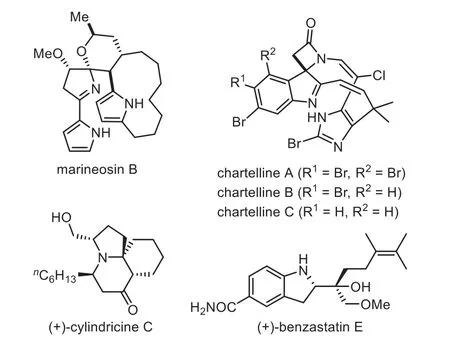
Fig.1.Examples of natural products and biologically active molecules containing chiral 1-pyrroline and derivatives.
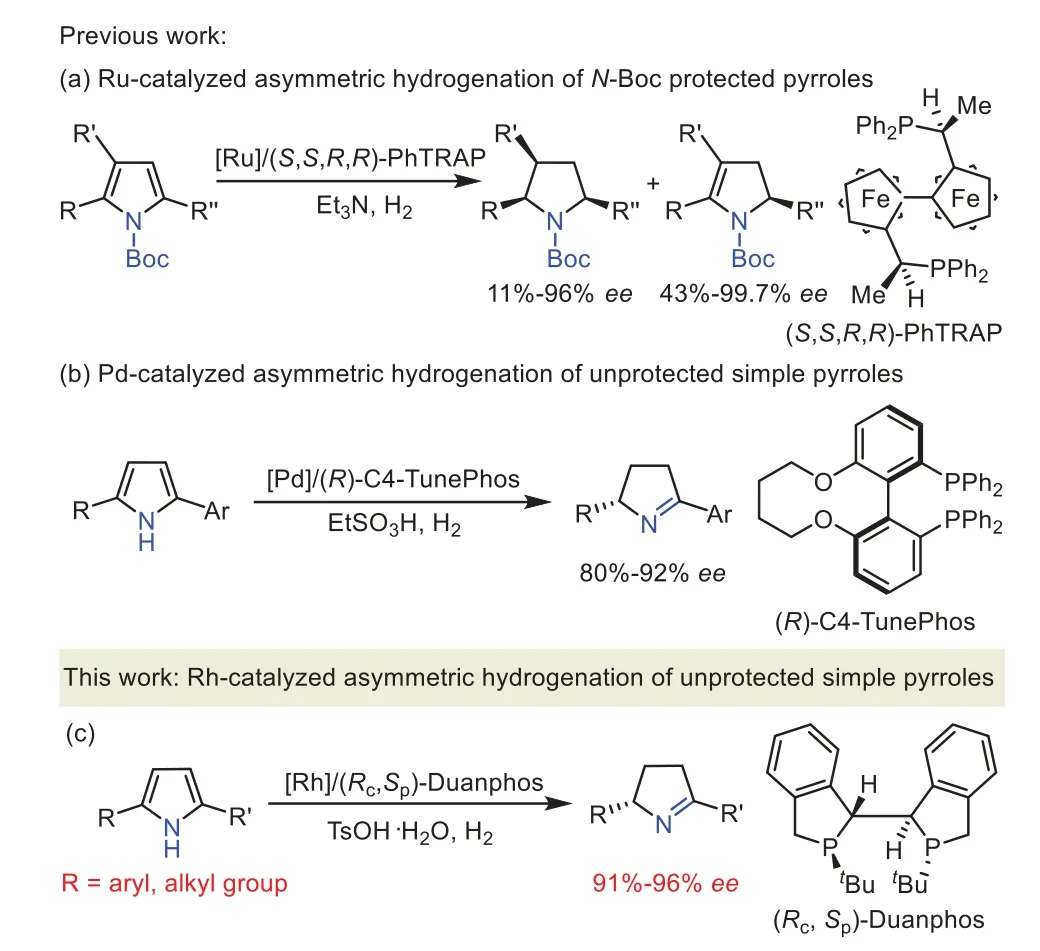
Scheme 1.Asymmetric hydrogenation of pyrroles.
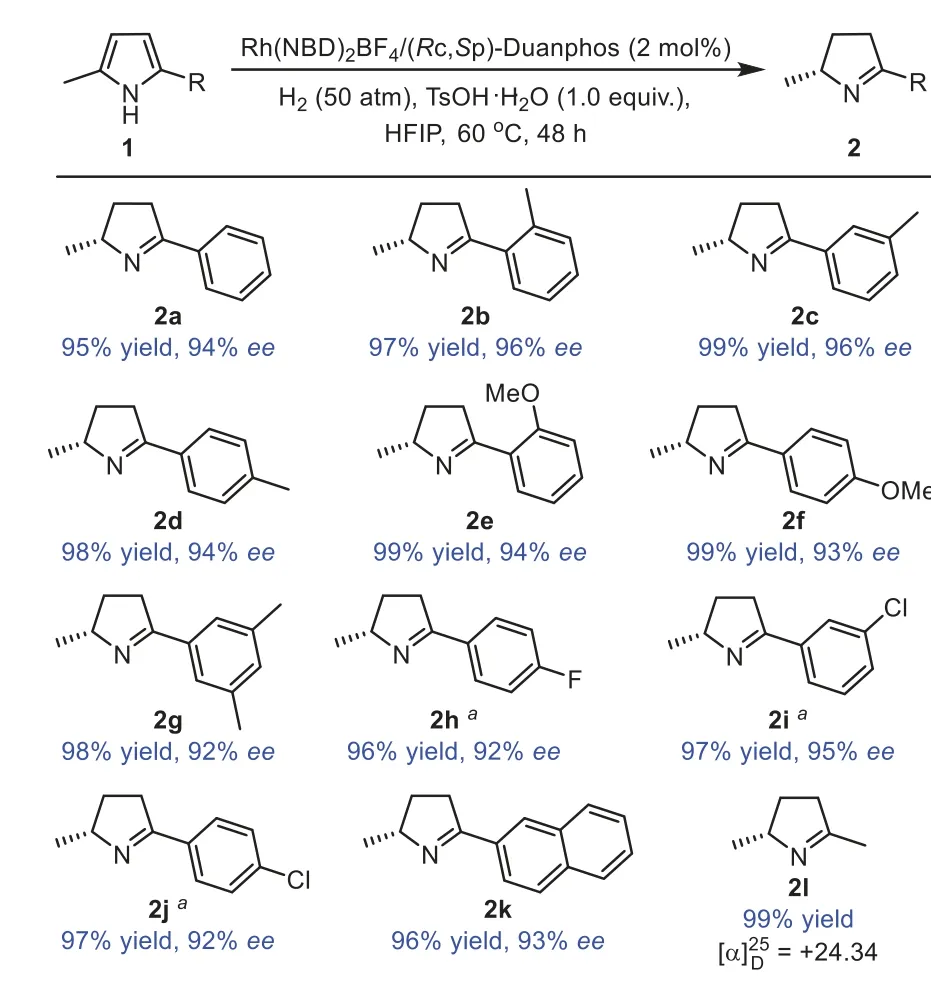
Scheme 2.Substrate scope study for Rh-catalyzed asymmetric hydrogenation of 2-methyl-5-aryl-1H-pyrroles.Unless otherwise mentioned,all reactions were carried out with a Rh(NBD)2 BF4/(R c,S p)-Duanphos/substrate 1(0.1 mmol)ratio of 2:2.2:100,1.0 equiv.TsOH·H2O in 1.0 mL HFIP under 50 atm H2 at 60°C for 48 h.Yield was isolated yield.Ee value was determined by HPLC on a chiral phase.a 5 mol%Rh(NBD)2BF4/(R c,S p)-Duanphos.
At the outset,2-methyl-5-phenylpyrrole 1a was chosen as the model substrate to investigate the reaction conditions for the asymmetric hydrogenation of pyrroles.Some metal precursors were employed in the presence of(Rc,Sp)-Duanphos ligand with TsOH·H2O as the activator in hexafluoroisopropanol(HFIP).To our delight,Rh(NBD)2BF4and Rh(COD)2BF4provided comparable results,the desired product 2a were obtained with promising reactivities and enantioselectivities(95%yield and 94%ee,92%yield and 91%ee,respectively,Table 1,entries 1 and 2).Iridiumcatalyzed asymmetric hydrogenation of 1a proceeded smoothly with high reactivities,but very pooreevalues were obtained(Table 1,entries 3 and 4).The examination of a series of commercially available chiral phosphine ligands was then carried out(Table 1,entries 5–10).We found that Rh/(R,R)-Quinoxp*could promote this transformation in good yield with excellent enantioselectivity(84%yield,90%ee,Table 1,entry 5).In addition,the axially chiral diphosphine ligands,such as(S)-Binap,(S)-Segphos and(S)-Synphos,did not provide satisfactory enantioselectivities(Table 1,entries 8–10).Therefore,(Rc,Sp)-Duanphos was selected as the best privileged ligand.

Table 1 Screening metal precursors and ligands for asymmetric hydrogenation of 1a.a
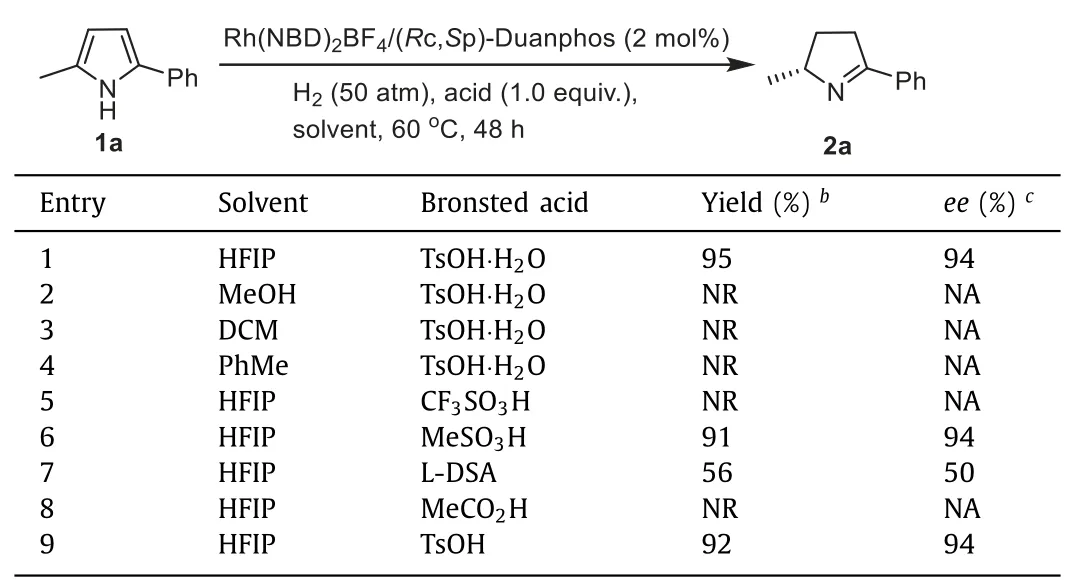
Table 2 Screening solvents and Brønsted acids for Rh-catalyzed asymmetric hydrogenation of 1a.a
Encouraged by these promising results,we further screened other reaction parameters including solvents and Brønsted acids.The investigation of solvent effect was firstly carried out,and revealed that this transformation did not proceed well in MeOH,DCM and toluene,the attempt to enhance the reaction efficiency by screening various solvents were unsuccessful(Table 2,entries 2–4).Considering the influence of Brønsted acid,a range of Brønsted acids with different strengths were then inspected.There is no reaction in the presence of CF3SO3H or MeCO2H(Table 2,entries 5 and 8).In addition,high yield and excellent enantioselectivity was provided with MeSO3H as the additive(91%yield,94%ee,Table 2,entry 6).The L-CSA(camphor sulfonic acid)also can promote this hydrogenation,albeitwith moderate result(56%yield,50%ee,Table 2,entry 7).Anhydrous TsOH was also examined,and comparable result could be obtained(Table 2,entry 9).Therefore,the optimal conditions were identified as Rh(NBD)2BF4/(Rc,Sp)-Duanphos(2 mol%),TsOH·H2O(1.0 equiv.),H2(50 atm)at 60°C(Table 2,entry 1).
Under the identical reaction conditions as above described,a variety of 2,5-disubstituted pyrrole derivatives were then subjected to explore the generality of this asymmetric hydrogenation process.As presented in Scheme 2,a broad range of 2-methyl-5-aryl-disubstituted pyrrole derivatives were compatible as good reaction partners,leading to the desired chiral partial hydrogenation products(R)-1-pyrrolines in generally high yields with excellent enantioselectivities(95%−99%yields,90%−96%ee).We found that the electronic effect and position of the substituted groups on the phenyl ring were well tolerated.The 2-alkyl-5-aryldisubstituted pyrrole derivatives containing electron-rich groups(1b-1g)or electron-deficient groups(1h-1j)participated smoothly to furnish the corresponding partial hydrogenation products(R)−1-pyrrolines(2b-2j)in 96%−99%yields with 92%−96%ee.Moreover,the position of the substituted group on the aryl group nearly has no effect on the reaction results,whether the substituted groups attached on theortho-,meta-orpara-position could participate efficiently.Remarkably,2-naphthyl fused pyrrole derivative 1k also worked well to generate the expected product 2k with excellent reaction result(96%yield,92%ee).In addition,2,5-dialklylpyrrole 2,5-dimethyl-1H-pyrrole 1l was examined in this catalytic system,affording the corresponding product 2l in 99%yield.

Scheme 3.Substrate scope study for Rh-catalyzed asymmetric hydrogenation of 2,5-disubstituted pyrroles.Unless otherwise mentioned,all reactions were carried out with a Rh(NBD)2BF4/(R c,S p)-Duanphos/substrate 1(0.1 mmol)ratio of 5:5.5:100,1.0 equiv.TsOH·H2O in 1.0 mL HFIP under 50 atm H2 at 60°C for 48 h.Yield was isolated yield.ee value was determined by HPLC on a chiral phase.a Rh(COD)2BF4/(Rc,Sp)-Zhaophos/substrates 1p-1s(0.1 mmol)ratio of 2:2.2:100,1.0 equiv.CF3SO3H in 1.0 mL HFIP:DCE(1:1)under 50 atm H2 at room temperature for 24 h.

Scheme 4.Large-scale Rh-catalyzed partial hydrogenation of 1a.

Scheme 5.Control experiment and possible process of asymmetric hydrogenation.
It is worth noting that the length and steric property of the alkyl chain of the 2-alkyl-5-aryl-disubstituted pyrrole derivatives have little influence on the reactivity and enantioselectivity(Scheme 3).When the methyl group was replaced to ethyl(1m),n-propyl(1n),isobutyl(1o)groups,the corresponding hydrogenation products(2m-2o)were generated in 96%−98%yields with 91%−95%ee.Rh-catalyzed asymmetric hydrogenation of 2,5-diaryl-1H-pyrrole substrates did not proceed smoothly under the standard reaction conditions.To our delight,they can be hydrogenated well by Rh(COD)2BF4/(Rc,Sp)-Zhaophos developed by our group[39]to deliver the desired products 2p-2r in high yields and good enantioselectivities(95%−98%yields,79%−82%ee).It’s worth noting that the methyl 4-(5-phenyl-1H-pyrrol-2-yl)benzoate(1s)containing different substituents on the phenyl ring was hydrogenated well with excellent regioselectivity and enantioselectivity(76%yield,69%ee).The structure and absolute configuration of 2s was determined to be as(S)through the X-ray analysis(CCDC:2159761).
In order to explore the potential synthetic utility,as shown in Scheme 4,Rh-catalyzed partial hydrogenation of 2-methyl-5-phenylpyrrole 1a on 3 mmol was conducted in the presence of low catalyst loading(0.2 mol%).To our delight,the desired product 2a could be easily accessible in high yield with maintained enantioselective control(96%conversion,88%yield,94%ee).
We found that there is no reaction in the absence of Brønsted acid,which demonstrated that it could play an important role in this asymmetric hydrogenation(Scheme 5a).Therefore,a possible reaction process was proposed based on the reaction results and previous studies[13].Strong Brønsted acid could react with the simple unprotected pyrrole to generate the iminium salt,which resulted in the destruction of the aromaticity of pyrrole and activated the pyrrole substrate.Thein situ-formed iminium salt was hydrogenated well by the rhodium catalytic system to produce the intermediate enamine,which was isomerized to the more stable imine product.
In summary,we have developed a highly enantioselective Rh-catalyzed partial hydrogenation of simple 2-alkyl-5-aryl-disubstituted pyrrole derivatives,affording various chiral 1-pyrrolines with excellent results(95%−99%yields,90%−95%eevalues).In addition,the 2,5-aryl-1H-pyrrole substrates can be performed well to deliver the desired products in high yields with good enantioselectivities.Based on the advantages of easily accessible substrates,wide substrate generality,excellent functional group tolerance,commercially available rhodium precursor and chiral ligand,this Rh-catalyzed asymmetric hydrogenation of simple pyrroles is expected to be important with great synthetic utilization.
Declaration of competing interest
The authors declare no competing financial interest.
Acknowledgments
We are grateful for financial support from the National Natural Science Foundation of China(No.22071187),the Natural Science Foundation of Jiangsu Province(No.BK20190213),and the Natural Science Foundation of Hubei Province(Nos.2020CFA036,2021CFA069).
Supplementary materials
Supplementary material associated with this article can be found,in the online version,at doi:10.1016/j.cclet.2022.04.027.
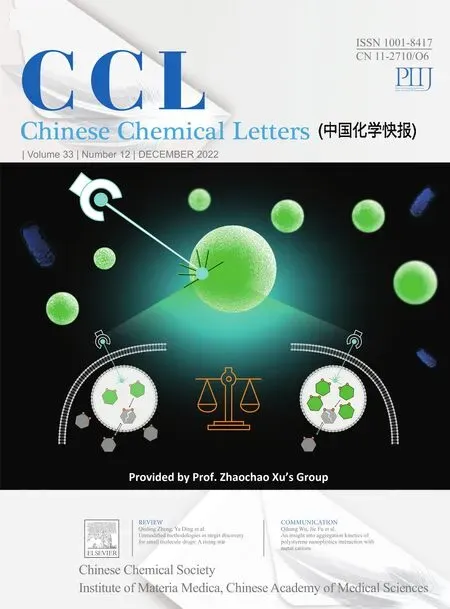 Chinese Chemical Letters2022年12期
Chinese Chemical Letters2022年12期
- Chinese Chemical Letters的其它文章
- Diverse strategic approaches en route to Taxol total synthesis
- Recent advances in gold-complex and chiral organocatalyst cooperative catalysis for asymmetric alkyne functionalization
- Unmodified methodologies in target discovery for small molecule drugs:A rising star
- Recent advances in single-crystalline two-dimensional polymers:Synthesis,characterization and challenges
- Environmental applications of graphene oxide composite membranes
- Recent advances in the application of metal organic frameworks using in advanced oxidation progresses for pollutants degradation
